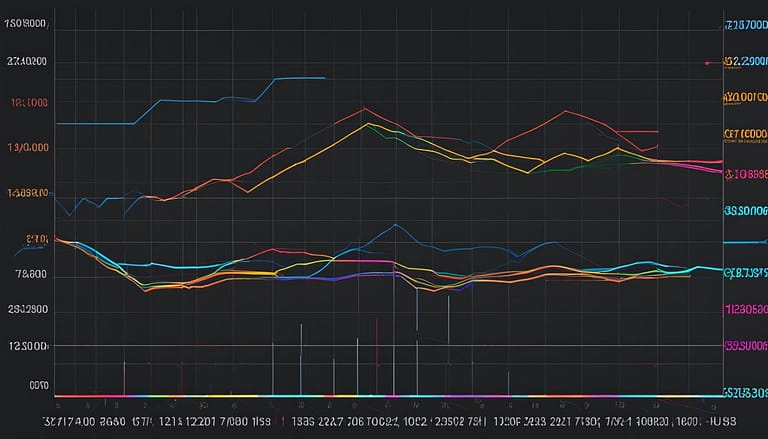Cryptocurrency Mining: An Investment Avenue
Embarking on the journey of Cryptocurrency Mining announces a foray into a world where the digital gold rush is very much alive—a realm dominated by the quest to mint new coins and achieve potential financial sovereignty. In the complex matrix of the financial landscape, Mining Investment is not merely a technical endeavour but a pursuit rife with promise and potentiality. The pursuit of Mining Profitability is transformative, extending beyond mere currency creation to embody a movement towards decentralized finance, pulling away from traditional banking systems and government oversight.
Canadian investors and technology enthusiasts are riding the crest of this sweeping trend, leveraging the power of blockchain technology to revolutionize how value is created and exchanged. Seamless global participation and controlled management of funds offer a paradigm shift in personal finance, propelling Bitcoin mining into a realm of attractive investment possibilities with lucrative high returns; a clear reflection of its volatile but dynamic market landscape.
Key Takeaways
- Delving into Cryptocurrency Mining introduces investors to a world of decentralized finance and possibility for autonomy.
- The allure of Mining Profitability remains, despite a volatile market, offering substantial rewards for those who navigate it well.
- Mining Investment transcends traditional fiscal practices, presenting an alternative avenue for financial growth in Canada.
- The growth of the mining sector signifies a turning point in personal finance, pushing the boundaries of what is possible for individual investors.
- Understanding the intricacies of Bitcoin mining is crucial for investors seeking to partake in this novel and potentially lucrative field.
Essentials of Cryptocurrency Mining
Mining cryptocurrency is far more than a mere creation of digital currency; it’s an integral component of maintaining and securing blockchain technology—a digital ledger that plays a pivotal role in the financial tapestry of decentralized transactions. With the demand for cryptocurrency mining on the rise, understandings of its fundamentals, from the mining process to the blockchain, and the critical functions of miners have never been more important for those considering its mining profitability.
Defining the Bitcoin Mining Process
Cryptocurrency mining is akin to a complex puzzle that, when solved, rewards the solver with new Bitcoin. The process validates and documents the myriad of transactions that occur on the Bitcoin network, with each successful mining operation securing a small piece of digital gold. Achieving success requires miners to compete against each other in solving cryptographic equations—proof of work that keeps the decentralized financial ecosystem thriving.
Blockchain Technology: The Foundation of Cryptocurrency Mining
At the very heart of cryptocurrency mining lies blockchain technology. This advanced data structure ensures transparency and establishes trust by documenting every transaction on a decentralized public ledger. Its use of SHA-256 cryptographic algorithms creates a secure, immutable chain, where each block is linked and secured using hashes from the previous block. This foundation enables not just security but longevity in the blockchain’s ever-expanding history of transactions.
The Role of Miners in Network Security
Miners are the custodians of the blockchain’s integrity and security. Their tireless efforts in confirming the validity of transactions serve as a bulwark against potential threats such as double-spending. The intensive energy required to conduct these operations is offset by the substantial reward of minting new Bitcoin—a process limited to a cap of 21 million coins, a factor that enhances mining profitability through its inherent scarcity.
Calculating Mining Profitability
For individuals and companies navigating the arena of cryptocurrency, understanding mining profitability is central to ensuring a wise Mining Investment. The rapid advancement of the digital currency market has made mining an extremely competitive and complex activity. While the allure of Block Rewards remains high, the route to attain them requires an in-depth analysis of several critical factors.
Factors Influencing Mining Investment Returns
Beyond the immediate cost of acquiring hardware and the ongoing expense of electricity, mining profitability is shaped by a diverse spectrum of elements. Market fluctuations, the current value of cryptocurrencies, hardware efficiency, and network difficulty levels are all pivotal. These intricate dynamics require consistent monitoring to optimize the return on Mining Investment.
Analyzing the Costs: Hardware and Electricity Expenses
The upfront investment into mining hardware can be substantial. Top-tier GPUs, efficient FPGAs, and powerful ASICs all come with significant price tags but offer varying degrees of computational capability. Coupled with this is the electricity cost, an expense that can swiftly erode Mining Profitability if not managed with precision.
Assessing Reward Potential and Block Rewards
Understanding the profit potential in cryptocurrency mining extends to comprehending Block Rewards – the new coins miners receive as an incentive for their contribution to validating transactions. The current reward sitting at 6.25 Bitcoins per block presents a tantalizing target, conditioned by the prevailing mining difficulty and the miner’s hash rate.
| Investment Cost | Operational Cost | Reward Potential | Difficulty and Hash Rate |
|---|---|---|---|
| Hardware acquisition | Electricity consumption | Block reward (6.25 BTC) | Current Network Difficulty |
| Software setup | Cooling systems | Transaction fees | Average Hash Rate |
| Maintenance | Internet charges | Price of Bitcoin | Frequency of rewards |
By meticulously balancing these variables, miners can sharpen their strategies in pursuit of the most enviable result: a lucrative outcome in the ever-expanding universe of Cryptocurrency Mining. Attention to detail and informed decision-making stand as the cornerstones of success in realizing profitable mining endeavors.
Understanding Mining Hardware and Software
As the cryptocurrency mining industry has evolved, so too has the technology that powers it. From humble beginnings with CPUs, miners now deploy sophisticated hardware and software to compete in this lucrative space.
The Evolution from CPUs to ASICs
In the early days of cryptocurrency, standard central processing units (CPUs) were sufficient for mining. However, as more individuals joined the mining race, graphics processing units (GPUs) became the tools of choice due to their greater efficiency. Today, Application-Specific Integrated Circuits (ASICs) are at the forefront, having taken over due to their unparalleled mining capabilities and efficiency in processing Mining Hardware computations.
Choosing the Right Mining Software
A crucial component that works in tandem with advanced hardware is Mining Software. This software connects your Mining Hardware to the blockchain network, enabling the mining process. Miner configuration, blockchain synchronization, and hash rate monitoring are all managed by software solutions tailored to various operating systems, ensuring round-the-clock mining efficiency.
Mining Pools vs Solo Mining
Mining individually, or ‘solo mining,’ was once a viable option when competition was low. Nowadays, for many, the choice of joining a mining pool is far more attractive. A pool combines the computational power of individual miners to increase the chances of mining a block, distributing the rewards proportionally, thus serving as a means for steady returns—even for those with limited ASICs capacity.
| Comparison Element | Solo Mining | Pool Mining |
|---|---|---|
| Hardware Requirements | High-grade ASICs necessary | Varied, more inclusive for different hardware |
| Rewards | Larger, yet infrequent, payouts | Smaller, more consistent payouts |
| Difficulty Level | High, with intense competition | Lower, through combined efforts |
| Operational Costs | Greater due to power and maintenance costs | Reduced, as costs are spread across the pool |
Cryptocurrency Mining Regulations in Canada
As the Canadian Crypto Landscape continues to mature, understanding the Mining Regulations is paramount for those involved in Cryptocurrency Mining. In Canada, the legal framework is developing to accommodate the technological nuances and economic implications of mining activities. Key provincial differences have emerged, reflecting a diverse regulatory environment.
In particular, Quebec has been proactive with its energy regulations, targeting the high consumption associated with mining operations. The province’s approach highlights a sophisticated understanding of the crypto industry’s demands and its interplay with public resources.
Canadian miners must tread carefully within the bounds of the law, declaring income from mining ventures and understanding the tax implications of their trading activities. The government’s classification of cryptocurrencies as commodities significantly impacts reporting and tax requirements.
Let’s consider the regulatory landscape across some Canadian provinces:
| Province | Regulatory Stance | Considerations for Miners |
|---|---|---|
| Quebec | Active energy regulation post-moratorium | Compliance with energy quota programs |
| British Columbia | Fosters technological innovation | Emphasis on sustainable practices |
| Alberta | Resource exploitation for mining | Opportunities with flare gas energy |
| Ontario | Engaging with fintech sector | Focus on legal compliance and innovation |
This table reflects just a snapshot of the Mining Regulations that form the mosaic of the Canadian Crypto Landscape, urging miners to adapt to localized legal requirements while capitalizing on the resources and opportunities each region presents.
Investment Strategies for Crypto Miners
As the digital currency industry evolves, crypto miners are becoming increasingly savvy about their investment strategies. Navigating through the volatile ecosystem of cryptocurrency requires a blend of short-term tactics and long-term planning. This delicate balance is crucial for miners who aim to optimize their return on investment while safeguarding against market unpredictability.
Long-term vs Short-term Mining Investments
Miners must choose between playing the long game, holding onto assets in anticipation of future value increases, and engaging in quick asset turnover to capitalize on market fluctuations. Long-term mining investments are often geared towards investors who are willing to bet on the gradual maturation and value appreciation of cryptocurrencies. Meanwhile, short-term strategies may yield quicker returns but come with the risk of rapid market changes outpacing the ability to react.
Diversifying Mining Portfolios
To mitigate these risks and capitalize on the market’s potential, diversifying mining portfolios is essential. Integrating traditional investment vehicles with crypto assets can provide a buffer against the unpredictable nature of digital currencies. A mixed investment strategy ensures that a downturn in the crypto market doesn’t translate into a wholesale loss of one’s portfolio value.
Risk Management in Crypto Mining Investments
Effective risk management is at the heart of sustainable mining investment. It begins with comprehensive due diligence, gaining a deep understanding of market conditions and technological advancements. Prudent investors must always consider the potential impacts of events such as Bitcoin halving and how they intersect with local mining regulations. This forward-thinking approach helps in constructing a resilient and profitable mining operation.
Here is a comparative analysis between long-term and short-term mining investments:
| Investment Type | Preferred Strategy | Risk Level | Potential Returns | Impact of Market Volatility |
|---|---|---|---|---|
| Long-term Mining Investments | Holding assets for future growth | Lower | High (over time) | Less impacted due to extended timeframe |
| Short-term Mining Investments | Quick turnover of assets | Higher | Varies (can be high) | Highly impacted by sudden market shifts |
By understanding the nuances of each investment approach, miners can make more informed decisions that align with their individual risk tolerance and financial goals. In addition, considering the diversification of mining portfolios can shield miners from the ebbs and flows that come with mining investments.
Ultimately, whether opting for long-term mining investments or embarking on short-term endeavors, strategic diversity in one’s portfolio is no longer a suggestion but a necessity in the modern age of cryptocurrency mining. The path to mining investment success lies in the ability to adapt, diversify, and manage risks with prudence and foresight.
The Canadian Crypto Mining Landscape
As the world witnesses an unprecedented interest in cryptocurrencies, Canadian Crypto Mining has emerged as a significant player on the global stage. The Crypto Mining Market in Canada has been emboldened by the country’s wealth of natural resources and investor-friendly conditions, propelling it to a noteworthy position in terms of Mining Profitability. Key players like Bitfarms and Hut 8 have anchored Canada’s reputation, leveraging renewable energy sources and technological innovations to scale their mining operations.
In particular, the province of Quebec offers an abundance of hydroelectric power, presenting a green and cost-effective solution for the energy-intensive mining processes. Alberta has not stayed behind, finding inventive ways to utilize flared gas, thus further diversifying the already rich Canadian energy mix for mining purposes. This efficient and environmentally conscious approach to energy harnesses Canada’s natural advantages, subsequently increasing mining profitability.
The following table provides a snapshot of the current state of Canadian Crypto Mining:
| Region | Energy Source | Hash Rate Contribution | Notable Mining Companies |
|---|---|---|---|
| Quebec | Hydroelectric Power | 3.1% | Bitfarms |
| Alberta | Flared Gas | 2.2% | Hut 8 |
| National Average | Mixed Sources | 7.8% | Various |
At present, estimates place the Canadian share of the global network hash rate at approximately 7.8%. This notable statistic underscores not only the expansion of the Crypto Mining Market within the nation but also the viability of Canada as a powerhouse for mining activities amidst global competition. It is a testament to the robustness of Canadian infrastructure and the foresight of leveraging its environmental wealth for technological advancement in digital currency mining.
“Canada possesses the unique combination of abundant renewable energy resources and innovative mining companies that together propel the nation to the forefront of the crypto mining industry.”
These insights into the Canadian landscape illustrate the country’s resolve to maintain a balance between technological growth and environmental stewardship, setting a precedent in the Crypto Mining Market worldwide. As industry participants continue to seek out regions that offer Mining Profitability, Canada’s commitment to sustainable mining practices certainly positions it as a magnet for both local and global crypto mining enterprises.
Financial Implications of Mining Rewards and Halving Events
The Bitcoin ecosystem is marked by cyclical events known as Bitcoin Halvings, which have monumental impacts on Mining Rewards and consequently, the overall Mining Profitability. These events serve as essential checkpoints that not only influence the earning potential for miners but also affect market dynamics on a broader scale. As we approach the next halving, understanding its financial implications is crucial for stakeholders in the mining sector.
Understanding Bitcoin Halving
At its core, a Bitcoin Halving event is a predetermined reduction in the number of bitcoins miners receive for adding a new block to the blockchain. This typically occurs every 210,000 blocks, which, due to the network’s design, happens approximately every four years. It’s an intentional feature of Bitcoin’s monetary policy aimed at reducing the inflation rate and introducing new coins more gradually as time progresses, mimicking the extraction of precious metals like gold.
The Impact of Halving on Mining Profitability
As each halving cuts rewards by half, miners are suddenly faced with a significant shift in revenue. The immediate effect is a drop in profitability for miners unless compensatory increases in the price of Bitcoin or enhancements in mining efficiency are realized. This phenomenon creates a market adjustment period where less efficient mining operations may halt, while others innovate to maintain profitability.
Projecting Future Trends in Bitcoin Rewards
Projecting future trends in Bitcoin mining after each halving demands careful examination of past events, current market conditions, and advancements in mining technology. While it is challenging to predict the exact outcomes, historical data reveals a pattern of price increases following halving events, which can offer a ray of hope for sustained mining incentives.
| Event | Reward Before Halving (BTC) | Reward After Halving (BTC) | Approximate Date |
|---|---|---|---|
| First Halving | 50 | 25 | November 2012 |
| Second Halving | 25 | 12.5 | July 2016 |
| Third Halving | 12.5 | 6.25 | May 2020 |
| Fourth Halving (Projected) | 6.25 | 3.125 | 2024 (Expected) |
Challenges and Risks in Cryptocurrency Mining
The venture of Cryptocurrency Mining offers a canvas of opportunity for appreciable income, yet it’s far from a simple endeavor. Investors interested in this market must navigate a labyrinth of Mining Challenges, with the operation’s vitality reliant on a robust infrastructure for computational effort and electricity. Initiating a mining rig involves a substantive financial commitment, not just for the equipment but also for the continuous power supply, which can introduce a stratum of financial and environmental quandaries.
The very essence of Cryptocurrency Mining is a testament to the unpredictable nature of the endeavor, fluctuating with the vicissitudes of Bitcoin’s market dynamics. These fluctuations embody the inherent volatility risks that can deflect trajectories of potential revenue overnight. Moreover, contingency is paramount due to possible regulatory alterations that stand to redefine the mining landscape abruptly — a testament that profitability in this arena is as volatile as the cryptocurrency market itself.
Additionally, the autonomous and decentralized nature of mining adds another layer of complexity in the form of security risks. Protecting the integrity of one’s mining setup against cyber threats is an ongoing battle that demands continuous vigilance and a sophisticated defense strategy to avert systemic vulnerabilities. In sum, the path to Mining Profitability is fraught with challenges and risks that must be meticulously assessed and managed to maintain a profitable mining operation in Canada’s ever-evolving digital currency terrain.










